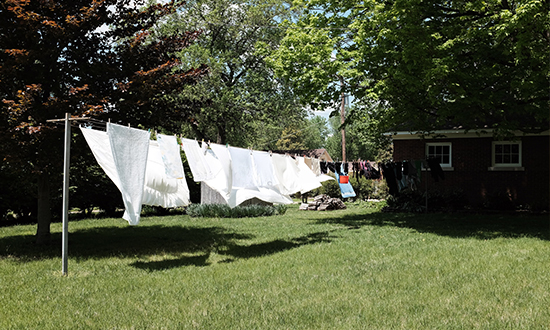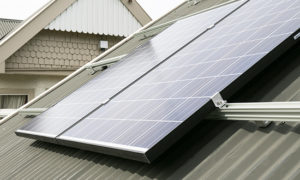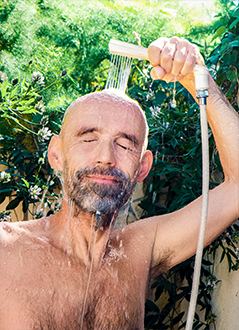The path to half-price electricity and a net-zero home

These days, we’re all used to convenience – hot water in an instant, entertainment at the touch of a button, laundry and dishes done by machines. But all this requires electricity, and it’s this convenience culture that is part of the climate change problem.
One way to reduce your impact is to use cleaner energy – like solar – but that’s only part of the picture. No matter how your energy is generated, it’s also essential to keep finding ways to reduce your overall power use. Using solar energy isn’t a license to crank up the heater or install a power-guzzling spa pool.
The ultimate goal is a net-zero home. Zero energy homes are just like any home—except better. They’re connected to the power grid, but are so air-tight, well insulated, and energy-efficient that they produce as much renewable energy as they consume over a year. This leaves the occupants with a net-zero energy bill, and a carbon-free home. If you use solar energy, it’s still important to reduce your power use, and make your home more efficient. This will get you as close as possible to zero. You’ll reduce your impact on the earth, and as a bonus, you could halve your power bill.
Where does our energy go?
Reducing your power usage starts with understanding it. Many people are unaware of what appliances or other items use the most power – they might be vigilant about switching off lights around the house, but still take long, hot showers.
According to a ten-year analysis of energy use, space heating is the biggest power consumer in the average Kiwi household, using around 34% of the total. However, this includes wood-burning fires, gas heaters, and other forms of heating – not just electricity. Another 29% goes on heating water for showers, dishwashing, and laundry. Fridges use 10%, lighting 8%, ovens and stoves 6%, and various other appliances make up the remaining 13%.
Although your household may use energy differently, it’s probably pretty similar. Knowing that space heating and water heating tend to use the most power, it makes sense to focus your efforts in those areas first.
Here are five ways to work toward a net-zero home:
- Stop energy leaks
It’s hard to keep your home at a comfortable temperature if heat is constantly escaping – or getting in. If your house isn’t well-insulated, you could be wasting power and money by sending heat out through the walls and windows.
Depending on your home, you could start by double-glazing windows, adding or renewing insulation in the floor, walls, and ceiling, hanging thermal-backed curtains or blinds, and sealing gaps around windows and doors. In some homes, overheating is an issue as well – covering your windows with shutters or external blinds can help keep your home cool in summer, without relying on fans or air conditioning.
- Change your hot water habits
Reducing your hot water use isn’t as hard as it sounds. Most clothing and linen can be washed in cold water. Take shorter showers, and consider installing a low-flow showerhead – this is the most effective way to control hot water usage. You can also turn down the temperature on your hot water cylinder – it should be no more than 60° to avoid scalding anyway. Although turning it down by a few degrees may not seem like much, your hot water cylinder is constantly heating a large volume of water, so it can make a big difference over time.
In the kitchen, make sure your dishwasher is full every time you run it – don’t waste power on a half load. If you run them when they’re full, dishwashers actually use water more efficiently than hand washing, so try to reduce that too. Don’t fill up the sink to wash a couple of wine glasses.
 Think before you buy
Think before you buy
A new washing machine or fridge can make a significant difference – try to find the most energy-efficient option. The energy star rating is a good place to start – the more stars, the more efficient the appliance.
It’s also smart to think about size – do you really need the largest fridge on the market, or would a smaller one do? For some appliances, the larger option might be a better choice. For example, if you have a big family, a larger washing machine will let you do the same amount of laundry in fewer loads, saving water and power overall.

- Small changes count
It’s a cliché, but small changes can make a big difference. Switch off lights when you leave a room, and turn other appliances off at the wall when you’re not using them – according to some studies, the power used to keep appliances in standby mode can account for up to 10% of household energy use. Switching to LED lighting is a small change that can make a surprisingly large impact, too.
Get in the habit of turning the water off while you’re shaving or brushing your teeth and, when the weather permits, hang your washing out on a clothes line rather than using the dryer.
- Strategic space heating
Space heating is the biggest consumer of energy, so think carefully before you choose to heat or cool your home. Of course, you want to be warm and comfortable, but that doesn’t mean switching on the heat pump or air conditioner at the slightest hint of a chill.
Use timers to switch heaters on and off at set times – they don’t generally need to be running all night. If you only use parts of the house, you don’t need to be heating the entire thing – so close doors and plug drafts.
In summer, try opening windows before using a fan or air conditioner.
If you’re building a house or installing a new air conditioning system, look for the most efficient solution. Heat pumps and ventilation systems may have lower running costs than electric heaters or gas heaters, but the best option will vary depending on the size and layout of your house.
- Going solar
 No matter how much you reduce your energy use, where you get your energy from matters too. The key to a low-impact home – and a lower electricity bill is solar power. If your system has a smart battery, like the one that comes with solarZero it could supply up to two thirds of your power needs and you can access additional grid power from Ecotricity who provides energy from 100% renewable sources. And you don’t need to make a big financial investment to add solar to your home. With solarZero’s unique solar-as-a-service option, you only pay for the solar energy you use, the system is provided for free, and there’s no ongoing maintenance costs either.
No matter how much you reduce your energy use, where you get your energy from matters too. The key to a low-impact home – and a lower electricity bill is solar power. If your system has a smart battery, like the one that comes with solarZero it could supply up to two thirds of your power needs and you can access additional grid power from Ecotricity who provides energy from 100% renewable sources. And you don’t need to make a big financial investment to add solar to your home. With solarZero’s unique solar-as-a-service option, you only pay for the solar energy you use, the system is provided for free, and there’s no ongoing maintenance costs either.
Want to find out whether SolarZero is right for you? Click here to see if you qualify to join the Grid for Good to generate power from your roof.










Join the Discussion
Type out your comment here:
You must be logged in to post a comment.